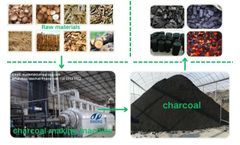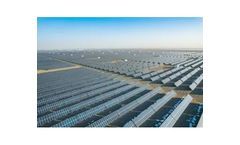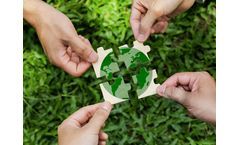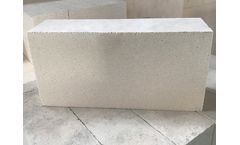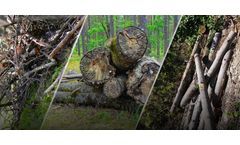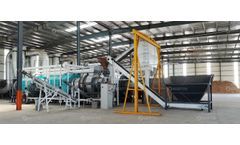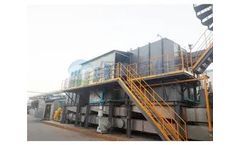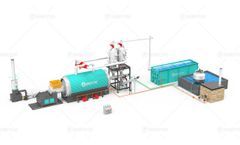Refine by
Incinerator Articles & Analysis
359 articles found
This process not only preserves the energy value of the raw materials but also significantly reduces the environmental pollution caused by direct incineration. Advantages of Using a Charcoal Maker Machine 1. High Resource Utilization: Charcoal maker machine can convert agricultural and forestry waste such as sawdust, fruit shells, and straw into useful energy, achieving a ...
This approach avoids landfill use and open incineration, both of which are significant sources of methane and black carbon emissions. ...
The Zichuan Solid Recovered Fuel (SRF) Plant Project is a mechanical pre-treatment facility for mixed municipal solid waste before incineration. It processes 1,000 tons of waste daily using two-stage shredding and mechanical separation to sort ferrous metals, non-combustibles (e.g., glass, stones, ash), and combustibles. ...
By converting plastic waste into valuable products, pyrolysis reduces the need for landfilling and incineration, both of which contribute to pollution and greenhouse gas emissions. ...
Power Generation: In boilers and incinerators. Why Invest in Mullite Insulation Bricks? While the upfront cost of mullite insulation bricks may seem high, their long-term benefits far outweigh the initial investment. ...
Traditional disposal methods, such as landfilling, incineration, or spreading on fields as fertilizer, come with their own set of challenges. Landfilling creates space issues and can result in the leaching of harmful substances into groundwater, while incineration often produces significant amounts of air pollution. Spreading manure-contaminated litter on fields ...
Environmental Benefits and Sustainability The production of plastic naphtha through pyrolysis offers a compelling alternative to traditional waste disposal methods, such as incineration or landfilling. By converting waste plastics into valuable hydrocarbon fuels, this process helps reduce environmental pollution and contributes to the sustainability of the petrochemical industry. ...
Utilizing Forest Waste as a Resource Forest waste, including branches, leaves, and other organic debris, often goes unused or is incinerated in open environments. This disposal method contributes to air pollution and forest degradation. ...
Rice husks are typically a byproduct of rice milling and are often discarded as waste, leading to environmental challenges if not properly managed. Instead of incinerating or landfilling the rice husks, which can incur significant disposal costs, carbonization through a rice husk carbonizer offers a sustainable alternative. ...
Contractor: Dutch Incinerators NL. Contract type: EPC, Project Management. Customer / Operator: ECO – SWM. ...
Contractor: Dutch Incinerators TH. Contract type: EPC – Turnkey supply. Customer / Operator: TES Group – Thailand. ...
Contractor: Dutch Incinerators TH. Contract type: EPC – Turnkey supply. Customer / Operator: TES Group – Thailand. ...
Contractor: Dutch Incinerators TH. Contract type: EPC – Turnkey supply. Customer / Operator: TES Group – Thailand. ...
Contractor: Dutch Incinerators TH. Contract type: EPC – Turnkey supply. Customer / Operator: TES Group – Thailand. ...
Contractor: Dutch Incinerators TH. Contract type: EPC – Turnkey supply. Customer / Operator: TES Group – Thailand. ...
Contractor: Employment contract. Learning experience: Plant upgrade, operations. Customer / Operator: Modern Asia. Environmental Holdings / Technochem. Project location: ...
Contractor: Employment contract. Learning experience: Plant upgrade, operations. Customer / Operator: Modern Asia. Environmental Holdings / WMS. Project location: Bang Poo / Thailand. Industry: Waste Management. Waste types: Hazardous chemical/industrial ...
Regenerative Thermal Oxidizer (RTO) uses the ceramic regenerators to store the heat generated by the decomposition of VOCs, and uses the thermal energy stored in the ceramic regenerator to pre-heat and decompose the untreated VOCs, thereby achieving high thermal efficiency. The oxidation temperature is generally between 800 ° C and 850 ° C, up to 1100 ° C. Regenerative Thermal ...
Regenerative Thermal Oxidizer (RTO) uses the ceramic regenerators to store the heat generated by the decomposition of VOCs, and uses the thermal energy stored in the ceramic regenerator to pre-heat and decompose the untreated VOCs, thereby achieving high thermal efficiency. The oxidation temperature is generally between 800 ° C and 850 ° C, up to 1100 ° C. Regenerative Thermal ...
Reduction of Greenhouse Gas Emissions: Compared to conventional waste disposal methods such as incineration, plastic pyrolysis generates lower levels of greenhouse gases. ...

